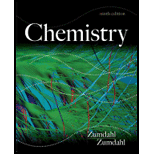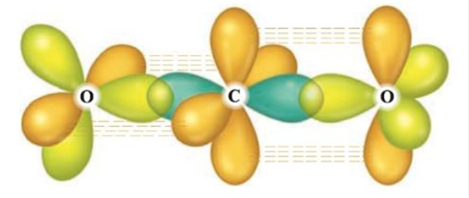
Chemistry
9th Edition
ISBN: 9781133611097
Author: Steven S. Zumdahl
Publisher: Cengage Learning
expand_more
expand_more
format_list_bulleted
Concept explainers
Textbook Question
Chapter 20, Problem 35E
The following illustration shows the orbitals used to form the bonds in carbon dioxide.

Each color represents a different orbital. Label each orbital, draw the Lewis structure for carbon dioxide, and explain how the localized electron model describes the bonding in CO2.
Expert Solution & Answer
Trending nowThis is a popular solution!

Students have asked these similar questions
Complete the mechanism
V
Biological Macromolecules
Drawing the Haworth projection of an aldose from its Fischer projection
Draw a Haworth projection of a common cyclic form of this monosaccharide:
H
C=O
HO
H
HO
H
H
OH
CH₂OH
Explanation
Check
Click and drag to start drawing a
structure.
X
Complete the mechanism
Chapter 20 Solutions
Chemistry
Ch. 20 - What are the two most abundant elements by mass in...Ch. 20 - Prob. 2RQCh. 20 - Prob. 3RQCh. 20 - What is the valence electron configuration for the...Ch. 20 - Prob. 5RQCh. 20 - Prob. 6RQCh. 20 - Table 19-14 lists some common nitrogen compounds...Ch. 20 - Prob. 8RQCh. 20 - Prob. 9RQCh. 20 - Prob. 10RQ
Ch. 20 - Prob. 1QCh. 20 - Prob. 2QCh. 20 - Prob. 3QCh. 20 - Diagonal relationships in the periodic table exist...Ch. 20 - Prob. 6QCh. 20 - Prob. 7QCh. 20 - Prob. 8QCh. 20 - All the Group 1A (1) and 2A (2) metals are...Ch. 20 - Prob. 10QCh. 20 - Prob. 13ECh. 20 - Prob. 14ECh. 20 - Prob. 15ECh. 20 - Prob. 16ECh. 20 - Prob. 17ECh. 20 - Prob. 18ECh. 20 - Prob. 19ECh. 20 - Prob. 20ECh. 20 - Prob. 21ECh. 20 - Electrolysis of an alkaline earth metal chloride...Ch. 20 - Prob. 24ECh. 20 - Prob. 25ECh. 20 - Prob. 26ECh. 20 - Boron hydrides were once evaluated for possible...Ch. 20 - Prob. 28ECh. 20 - Prob. 29ECh. 20 - Prob. 30ECh. 20 - Prob. 31ECh. 20 - Prob. 32ECh. 20 - Prob. 33ECh. 20 - Prob. 34ECh. 20 - The following illustration shows the orbitals used...Ch. 20 - Prob. 36ECh. 20 - Silicon is produced for the chemical and...Ch. 20 - Prob. 38ECh. 20 - The compound Pb3O4 (red lead) contains a mixture...Ch. 20 - Prob. 40ECh. 20 - Prob. 41ECh. 20 - Prob. 42ECh. 20 - Prob. 43ECh. 20 - Prob. 44ECh. 20 - Prob. 45ECh. 20 - Prob. 46ECh. 20 - Prob. 47ECh. 20 - Prob. 48ECh. 20 - Prob. 49ECh. 20 - Phosphate buffers are important in regulating the...Ch. 20 - Prob. 51ECh. 20 - Trisodium phosphate (TSP) is an effective grease...Ch. 20 - Prob. 53ECh. 20 - Prob. 54ECh. 20 - Prob. 55ECh. 20 - Complete and balance each of the following...Ch. 20 - Prob. 57ECh. 20 - Prob. 58ECh. 20 - How can the paramagnetism of O2 be explained using...Ch. 20 - Describe the bonding in SO2 and SO3 using the...Ch. 20 - Write the Lewis structure for O2F2. Predict the...Ch. 20 - Give the Lewis structure, molecular structure, and...Ch. 20 - Prob. 63ECh. 20 - Prob. 64ECh. 20 - Prob. 65ECh. 20 - Prob. 66ECh. 20 - Prob. 67ECh. 20 - Prob. 68ECh. 20 - Prob. 69ECh. 20 - Prob. 70ECh. 20 - Prob. 71ECh. 20 - Prob. 72ECh. 20 - Prob. 73AECh. 20 - The inert-pair effect is sometimes used to explain...Ch. 20 - How could you determine experimentally whether the...Ch. 20 - Prob. 76AECh. 20 - Prob. 77AECh. 20 - Prob. 78AECh. 20 - Prob. 79AECh. 20 - Draw Lewis structures for the AsCl4+ and AsCl6...Ch. 20 - Prob. 81AECh. 20 - Prob. 82AECh. 20 - Prob. 83AECh. 20 - What is a disproportionation reaction? Use the...Ch. 20 - Sulfur forms a wide variety of compounds in which...Ch. 20 - Prob. 86AECh. 20 - Prob. 87CWPCh. 20 - Prob. 88CWPCh. 20 - Prob. 89CWPCh. 20 - Prob. 90CWPCh. 20 - Prob. 91CWPCh. 20 - Nitrous oxide (N2O) can be produced by thermal...Ch. 20 - What is the hybridization of the central atom in...Ch. 20 - Prob. 94CWPCh. 20 - Prob. 95CWPCh. 20 - Prob. 96CWPCh. 20 - Prob. 97CPCh. 20 - Prob. 98CPCh. 20 - Lead forms compounds in the +2 and +4 oxidation...Ch. 20 - Prob. 100CPCh. 20 - Prob. 101CPCh. 20 - Prob. 102CPCh. 20 - You travel to a distant, cold planet where the...Ch. 20 - Prob. 104CPCh. 20 - Prob. 105CPCh. 20 - Prob. 106IPCh. 20 - Prob. 107IPCh. 20 - Although nitrogen trifluoride (NF3) is a thermally...Ch. 20 - While selenic acid has the formula H2SeO4 and thus...Ch. 20 - Prob. 110MPCh. 20 - Prob. 111MP
Knowledge Booster
Learn more about
Need a deep-dive on the concept behind this application? Look no further. Learn more about this topic, chemistry and related others by exploring similar questions and additional content below.Similar questions
- Complete the mechanismarrow_forward8 00 6 = 10 10 Decide whether each of the molecules in the table below is stable, in the exact form in which it is drawn, at pH = 11. If you decide at least one molecule is not stable, then redraw one of the unstable molecules in its stable form below the table. (If more than unstable, you can pick any of them to redraw.) Check OH stable HO stable Ounstable unstable O OH stable unstable OH 80 F6 F5 stable Ounstable X Save For Later Sub 2025 McGraw Hill LLC. All Rights Reserved. Terms of Use | Privacy C ཀྭ་ A F7 매 F8 F9 4 F10arrow_forwardJust try completing it and it should be straightforward according to the professor and TAs.arrow_forward
- The grading is not on correctness, so if you can just get to the correct answers without perfectionism that would be great. They care about the steps and reasoning and that you did something. I asked for an extension, but was denied the extension.arrow_forwardShow your work and do something that is reasonable. It does not have to be 100% correct. Just show something that looks good or pretty good as acceptable answers. Something that looks reasonable or correct would be sufficient. If you can get many of them correct that would be great!arrow_forwardShow your work and do something that is reasonable. It does not have to be 100% correct. Just show something that looks good or pretty good as acceptable answers. Something that looks reasonable or correct would be sufficient. If you can get many of them correct that would be great!arrow_forward
- Take a look at the following molecule, and then answer the questions in the table below it. (You can click the other tab to see the molecule without the colored regions.) with colored region plain 0= CH2-0-C-(CH2)16-CH3 =0 CH-O-C (CH2)7-CH=CH-(CH2)5-CH3 D CH3 | + OMPLO CH3-N-CH2-CH2-0-P-O-CH2 B CH3 A Try again * 000 Ar 8 0 ?arrow_forwardShow your work and do something that is reasonable. It does not have to be 100% correct. Just show something that looks good or pretty good as acceptable answers.arrow_forwardShow your work and do something that is reasonable. It does not have to be 100% correct. Just show something that looks good or pretty good as acceptable answers.arrow_forward
- = 1 = 2 3 4 5 6 ✓ 7 8 ✓ 9 =10 Devise a synthesis to prepare the product from the given starting material. Complete the following reaction scheme. Part 1 of 3 -Br Draw the structure for compound A. Check Step 1 Step 2 A Click and drag to start drawing a structure. × ↓m + OH Save For Later S 2025 McGraw Hill LLC. All Rights Reserved. Terms of Use | Privaarrow_forwardPredict the products of this organic reduction: 田 Check AP + + H2 Lindlar catalyst Click an drawing 2025 McGraw Hill LLC. All Rigarrow_forward70 Suppose the molecule below is in acidic aqueous solution. Is keto-enol tautomerization possible? • If a keto-enol tautomerization is possible, draw the mechanism for it. Be sure any extra reagents you add to the left-hand sid available in this solution. • If a keto-enol tautomerization is not possible, check the box under the drawing area. : ☐ Add/Remove step Click and drag to st drawing a structure Check Save For Late. 2025 McGraw Hill LLC. All Rights Reserved. Terms of Usearrow_forward
arrow_back_ios
SEE MORE QUESTIONS
arrow_forward_ios
Recommended textbooks for you
 Chemistry: The Molecular ScienceChemistryISBN:9781285199047Author:John W. Moore, Conrad L. StanitskiPublisher:Cengage Learning
Chemistry: The Molecular ScienceChemistryISBN:9781285199047Author:John W. Moore, Conrad L. StanitskiPublisher:Cengage Learning Chemistry: Principles and PracticeChemistryISBN:9780534420123Author:Daniel L. Reger, Scott R. Goode, David W. Ball, Edward MercerPublisher:Cengage Learning
Chemistry: Principles and PracticeChemistryISBN:9780534420123Author:Daniel L. Reger, Scott R. Goode, David W. Ball, Edward MercerPublisher:Cengage Learning Chemistry & Chemical ReactivityChemistryISBN:9781337399074Author:John C. Kotz, Paul M. Treichel, John Townsend, David TreichelPublisher:Cengage Learning
Chemistry & Chemical ReactivityChemistryISBN:9781337399074Author:John C. Kotz, Paul M. Treichel, John Townsend, David TreichelPublisher:Cengage Learning Chemistry & Chemical ReactivityChemistryISBN:9781133949640Author:John C. Kotz, Paul M. Treichel, John Townsend, David TreichelPublisher:Cengage Learning
Chemistry & Chemical ReactivityChemistryISBN:9781133949640Author:John C. Kotz, Paul M. Treichel, John Townsend, David TreichelPublisher:Cengage Learning General Chemistry - Standalone book (MindTap Cour...ChemistryISBN:9781305580343Author:Steven D. Gammon, Ebbing, Darrell Ebbing, Steven D., Darrell; Gammon, Darrell Ebbing; Steven D. Gammon, Darrell D.; Gammon, Ebbing; Steven D. Gammon; DarrellPublisher:Cengage Learning
General Chemistry - Standalone book (MindTap Cour...ChemistryISBN:9781305580343Author:Steven D. Gammon, Ebbing, Darrell Ebbing, Steven D., Darrell; Gammon, Darrell Ebbing; Steven D. Gammon, Darrell D.; Gammon, Ebbing; Steven D. Gammon; DarrellPublisher:Cengage Learning Chemistry for Engineering StudentsChemistryISBN:9781285199023Author:Lawrence S. Brown, Tom HolmePublisher:Cengage Learning
Chemistry for Engineering StudentsChemistryISBN:9781285199023Author:Lawrence S. Brown, Tom HolmePublisher:Cengage Learning

Chemistry: The Molecular Science
Chemistry
ISBN:9781285199047
Author:John W. Moore, Conrad L. Stanitski
Publisher:Cengage Learning

Chemistry: Principles and Practice
Chemistry
ISBN:9780534420123
Author:Daniel L. Reger, Scott R. Goode, David W. Ball, Edward Mercer
Publisher:Cengage Learning

Chemistry & Chemical Reactivity
Chemistry
ISBN:9781337399074
Author:John C. Kotz, Paul M. Treichel, John Townsend, David Treichel
Publisher:Cengage Learning

Chemistry & Chemical Reactivity
Chemistry
ISBN:9781133949640
Author:John C. Kotz, Paul M. Treichel, John Townsend, David Treichel
Publisher:Cengage Learning

General Chemistry - Standalone book (MindTap Cour...
Chemistry
ISBN:9781305580343
Author:Steven D. Gammon, Ebbing, Darrell Ebbing, Steven D., Darrell; Gammon, Darrell Ebbing; Steven D. Gammon, Darrell D.; Gammon, Ebbing; Steven D. Gammon; Darrell
Publisher:Cengage Learning

Chemistry for Engineering Students
Chemistry
ISBN:9781285199023
Author:Lawrence S. Brown, Tom Holme
Publisher:Cengage Learning
NEET Chemistry | Group 14 Carbon Family | Theory & Problem Solving | In English | Misostudy; Author: Misostudy;https://www.youtube.com/watch?v=enOGIrcHh54;License: Standard YouTube License, CC-BY